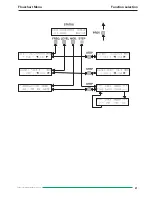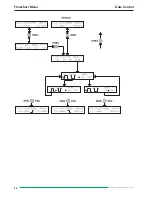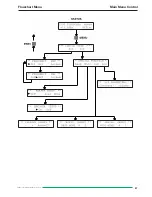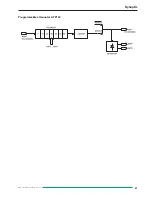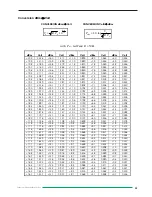
18
Subject to change without notice
The line (9) allows you to turn the AM modulation on or off. The
parameters «1» or «ON» turn the AM on, and «0» or «OFF»
turn the modulation off (if present).
The line (10) asks the current AM state to the instrument. It
sends back «0» (char zero) if no AM is in progress, «1» (char
one) if AM is present.
Example:
:AM:INT:FREQ 3000; SHAP SQU; DEPT 60; STAT 1
Commands tree - FM (Frequency Modulation)
It brings together the commands of the FM.
Syntax:
:FM[:DEViation] <NUM>
(1)
:FM[:DEViation]?
(2)
The line (1) allows you to modify the FM deviation. The
<NUM> parameter is a NR1 or NR2 or NR3 number in the
range covered by the instrument. None unit must follow the
number, Hz unit is the default one. The value is garbled (same
as the keypad) to the resolution. The line (2) asks the current
FM deviation to the instrument. It sends back a string
representing a NR3 decimal number.
:FM:SOURce INTern | EXTern
(3)
:FM:SOURce?
(4)
The line (3) allows you to set the modulation source and at the
same time turns the FM on. The line (4) asks the FM source
to the instrument. It sends back the strings INT or EXT (not
INTERN or EXTERN).
If the FM is turned off, the string INT is sent back because this
source is the default setting for the «FM:STAT 1» command
(the operation is the same as the keypad).
:FM:INTern:FREQuency <NUM>
(5)
:FM:INTern:FREQuency?
(6)
The line (5) allows you to change the frequency of the internal
modulation signal. The <NUM> parameter is a NR1 or NR2 or
NR3 number in the range covered by the instrument. None
unit must follow the number, Hz unit is the default one. The
value is garbled (same as the keypad) to the resolution.
The line (6) asks the current modulation frequency to the
instrument. It sends back a string representing a NR3 decimal
number.
:FM:INTern:SHAPe SIN | SQU
(7)
:FM:INTern:SHAPe?
(8)
The line (7) allows you to change the shape of the internal
modulation signal. The parameters are : SIN for a sine signal,
SQU for square. The line (8) asks the current shape to the
instrument. It sends back the same strings as the corresponding
command parameters above.
:FM:STATe 0 | OFF | 1 | ON
(9)
:FM:STATe?
(10)
The line (9) allows you to turn the FM on or off. The parameters
«1» or «ON» turn it on, and «0» or «OFF» turn the modulation
off (if present). The line (10) asks the current FM state to the
instrument. It sends back «0» (char zero) if no FM is in
progress, «1» (char one) if FM is present.
:FM:MODE ANA | NUM
(11)
:FM:MODE?
(12)
The line (11) allows you to switch the operating mode
(depending on the input bandwidth expected) of the external
modulation. The parameters ANA and NUM are the same as
the options in the external FM menu (refer to the corresponding
paragraph ).
The line (12) asks the current mode to the instrument. It sends
back the same strings as the corresponding command
parameters above.
:FM:EXTern:COUPling AC | DC
(13)
:FM:EXTern:COUPling?
(14)
The line (13) allows you to switch the external input modulation
in AC or DC mode. The line (14) asks the current state to the
instrument. It sends back the same strings as the corresponding
command parameters above.
Example:
FM:INT:FREQ 9E+3; SHAP SIN; DEV 150E+3;
MODE NUM; STAT ON
Commands tree - PM (Phase Modulation)
It brings together the commands of the PM.
Syntax:
:PM[:DEViation] <NUM>
(1)
:PM[:DEViation]?
(2)
The line (1) allows you to modify the PM deviation. The
<NUM> parameter is a NR2 number in the range covered by
the instrument. None unit must follow the number, the current
unit is the default one. If the value has an accuracy higher than
the resolution, the number is rounded to the corresponding
digit.
The line (2) asks the current PM deviation to the instrument.
It sends back a string representing a NR2 decimal number
(without the unit).
:PM:UNIT RAD | DEG
(3)
:PM:UNIT?
(4)
The line (3) allows you to change the current unit. Two
parameters are possible : RAD for radian or DEG for degree.
The line (4) asks the current unit to the instrument. It sends
back the same strings as the corresponding command
parameters above.
:PM:SOURce INTern | EXTern
(5)
:PM:SOURce?
(6)
The line (5) allows you to set the modulation source and at the
same time turns the PM on. The line (6) asks the PM source
to the instrument. It sends back the strings INT or EXT (not
INTERN or EXTERN). If the PM is turned off, the string INT is
sent back because this source is the default setting for the
Operation - Commands tree
Summary of Contents for HM8134-2
Page 1: ...Instruments MANUAL HANDBUCH MANUEL Programmable Synthesizer HM8134 2 ENGLISH...
Page 2: ...LEER...
Page 21: ...21 Subject to change without notice Flowchart Menu Function selection...
Page 22: ...22 Subject to change without notice Flowchart Menu Step Control...
Page 23: ...23 Subject to change without notice Flowchart Menu Amplitude Modulation Control...
Page 24: ...24 Subject to change without notice Flowchart Menu Phase Modulation Control...
Page 25: ...25 Subject to change without notice Flowchart Menu Frequency Modulation Control...
Page 26: ...26 Subject to change without notice Flowchart Menu Gate Control...
Page 27: ...27 Subject to change without notice Flowchart Menu Main Menu Control...
Page 28: ...28 Subject to change without notice Referency loop CREF Synoptic Principal loop PLL1 134...
Page 29: ...29 Subject to change without notice Secondary loop PLL2 134 Synoptic Transposition TRA 134...
Page 31: ...31 Subject to change without notice Programmable attenuator ATP134 Synoptic...
Page 37: ...37 Subject to change without notice...
Page 38: ...38 Subject to change without notice...
Page 39: ...LEER...


















